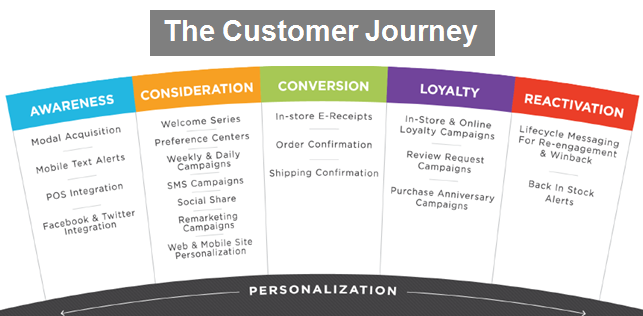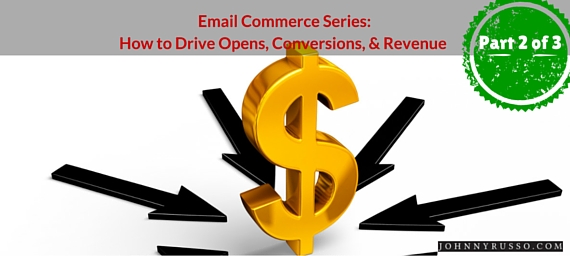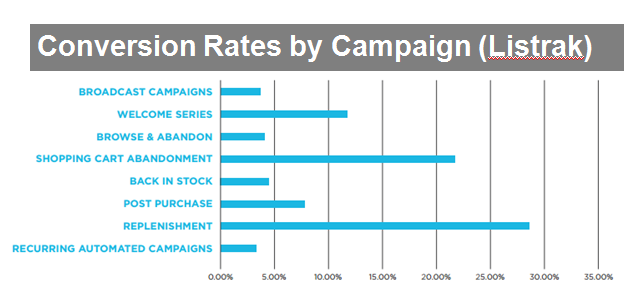Part 1 of the email series talked about welcome and cart abandonment emails, which everyone should at least be launching and testing. Part 2 of this series focuses on other lesser-known, yet equally effective ways to drive revenue via email.
So while cart abandonment is gaining in popularity, what about the little talked about act of browsing and abandoning? So when someone comes to your site and browses different products, but does not add them to their cart, why not retarget them?
Browse and Abandon Can Have Open Rates Higher Than 37%
They obviously had some kind of interest in your products. These campaigns generate the highest open rate of any email series at over 37% with an average conversion rate of 4%, which are amazing numbers. And not many brands are doing this, so take that opportunity to get ahead and test these campaigns.
Post Purchase Campaigns – Follow The Customer Journey Even After The Sale
We all have friends who call us just when they need something. If you’re not checking up on your customer port-purchase, you are doing a similar thing. Post purchase campaigns are not order confirmation or transactional emails, although they can be. What I’m talking about here is the post purchase emails that can be designed to be triggered a few days after the purchase; maybe it’s for a review of the product or service; perhaps it’s just to check up on your customer or ask them to respond to a survey; or it can be an upsell email to get them to buy something again.
Whatever the tactic, use post purchase emails as part of your strategy, as they convert at almost 8%, with an open rate of over 30%.

Upsell Email Offer Should Be At Least 60% Cheaper Than Item Purchased
Now here’s something to keep in mind, when upselling in general, but specifically as it relates to email. The upsell offer should be at least 60% cheaper than the product they added to the cart or bought. So, for example, if you work for a fashion retailer, when men buy a shirt and pants, but no tie, you should think about designing an automated post purchase email with a selection of ties. And when a woman buys several skirts but no blouses, why not send her a post purchase campaign with blouses? If your brand sells consumer electronics, when someone buys an iPad, the post purchase upsell should be an iPad cover, and not necessarily an iWatch. And I think it goes without saying, but try to only offer related products – don’t go off the board into some new category, as this is not the time nor place for it.
We’re now seeing a lot more user-generated content as part of the post purchase campaigns, that’s to say social network feeds of the item you bought being used by others. Pretty interesting stuff and engaging material. Try it and see how it works for your customers.
The Arms Race Between Amazon and Wal-Mart – and How You Can Compete Too!
And why stop at post purchase. What about replenishment campaigns? Bentley Leathers sells luggage. That is a long sales cycle in between a recent luggage purchase and the next luggage purchase, seeing as how luggage lasts anywhere from 3-7 years. Why not develop a triggered replenishment campaign, even if Bentley has to set it to 3 years out?
If you sell things that use up quickly, like vitamins, there’s an even greater opportunity for you. If there are 30 vitamins in a pill box, then hit them with a replenishment campaign on day 22 or day 23. I started buying all my deodorants and vitamins on Amazon. And sure, the first time you buy deodorant on Amazon, it could feel a little strange. But believe you me, replenishment campaigns are successful and since they are based on average usage, are pretty convenient for the consumer. Replenishment campaigns also drive the highest conversion rate of any series. They are super personalized. And it’s super cool to understand their algorithm. One thing I have not yet bought on Amazon is cologne, but I’d love to know how they calculate replenishment for that. I’ll probably tweet about that once I know, but what is the average use of a 100ml cologne or perfume bottle?
It’s fair to say that Amazon and Wal-Mart are in an arms race to see who can win this battle. But we can all compete. It’s a pretty simple formula: design the rule, design the campaign, hit send, analyse and test. Granted, there is some technology that needs to play in the background, but you get the point.
Back in Stock Emails Can Recover Lost Sales
If you have a lot of items that are out of stock on your website, or numerous orders on your site end up being put on back order, perhaps a “back in stock” email campaign would do you some good. This campaign drives the most click-throughs and revenue per email out of any email campaign. And it’s not surprising, since the customer obviously wants or wanted this product.
Back in Stock emails have the highest revenue per email at $6.50 with a CTR of 9.54%. To set up this campaign, you may need to work with a programmer, but simply provide a “buy when back in stock” link, button, or widget and have that data linked to your email tool. On the email tool side, ensure you set up a back in stock campaign that is automatically triggered when the item is back in your inventory.
Triggered Email Campaigns: Relevant Content Meets Relevant Context
To maximize efficiency, you should design email campaigns to be triggered or automated based on a particular action or behaviour, or lack thereof (think of a customer not purchasing for 6 months). With a low open rate of just over 10%, you might think mass email sends are better. But when you look at the conversion rate from automated campaigns (3.32%), it means that people that open this email are converting. Remember that when relevant content meets relevant context, conversions tend to naturally follow.
Email Should Be at the Core of Your Digital Strategy
All email campaigns in this study by Listrak have a conversion rate of 3% or over. The lowest are broadcast and recurring automated campaigns, which are still over 3.3%. So email as a channel is very healthy.
Other Ways to Drive Revenue Via Email
So far in parts 1 and 2 of this 3-part email series on How to Drive Opens, Conversions, and Revenue, we’ve discussed core email strategies. But what about building your list? What about testing and optimization? In the third and final part of this series, we’ll discuss gaining new subscribers, testing, and how to best optimize your email for mobile and tablet to get quick wins.
Series 1 in the series will outline potential welcome and cart abandonment email strategies.
Series 3 in the series will take a look at email acquisition, testing, call to actions, mobile subject lines, and optimizing for desktop, mobile, and tablet.
How are your triggered campaigns performing?





Interesting insight, I look forward in reading the 3rd installment in the series. It would be interesting to get your perspective on the customer service aspect of the whole online shopping experience.
Spending time to analyze a campaign is important, but in some ways it’s like doing an autopsy after the patient has past. I’ve noticed far too many organizations emphasizing customer service as a reactive way to helping a customer after they’ve purchased. Going through a campaign and waiting to make the changes to improve on the strategy on the next campaign can be expensive and frustrating. Why not approach customer service as a proactive means in helping customers? Wouldn’t this help in increasing sales?
If you believe this would be a topic of interest to the extended community, I’d be willing to collaborate with you in writing a blog on this subject.